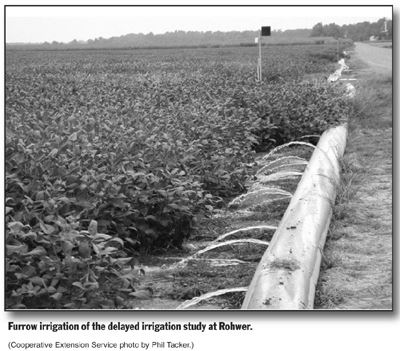Various Studies Look At Timing Of Irrigation During Growing Season
LITTLE ROCK, ARK.
Cultural changes in farming have necessitated a change in how farmers think about irrigation. The University of Arkansas Division of Agriculture is working with farmers to adapt to new ways of thinking when it comes to watering soybeans.
Phil Tacker, associate professor- extension engineer with the Division, says many producers now plant shorter season varieties earlier. These beans are usually maturing in August, when temperatures are still 90 degrees or warmer and conditions are dry. The high temperatures and dry conditions make it imperative to keep irrigation on the fields longer to get the full benefit of water, which increases bean weight.
“With soybean promotion board funding, we’ve been conducting two different studies related to the timing of irrigation,” says Tacker.
The first study, completed in 2006, focused on the timing of the final irrigation on soybeans.
“We looked at ending irrigation for different maturity groups at various growth stages from about R5 to R7. This is a little later than a few years ago when we thought irrigation wasn’t needed after R6 growth stage,” Tacker says.
Data showed a positive yield response of three to five bushels per acre by irrigating as late as R6.5 growth stage, when growing conditions were hot and dry.
“That increase more than offsets the cost of one final irrigation,” says Tacker. Considering the cost of watering and the price producers get for their beans, the return is typically above what it costs for that final irrigation.
The second study focuses on delaying the initial irrigation after soybeans are planted. The work is being conducted at the Rowher Research Station and through on-farm demonstrations in Clay County.

“We worked with four farmers, two in the western part of the county and two in the eastern part,” says Ron Baker, Clay County agent based in Corning.
Baker says three test plots were created on each farmer’s field. Irrigation was delayed by one week on each of the test plots. The initial irrigation delay was the only change made on the test plots; everything else, including fertilization, herbicide application and subsequent irrigation, remained the same.
“At harvest, we cut the three test plots, calculated the average yield and compared that with the average yield of the rest of the crop,” says Baker. “We found that, in the sandier soils, delaying irrigation by one week had a significant impact on the crop. The difference was about three bushels per acre less.”
Delaying irrigation even three to five days can result in a yield loss that can't be recovered even if the crop's moisture requirement is met through the season.
The research conducted on a farmer’s field may not be as intense as it is at the experiment stations, but it helps farmers see on their own fields what works and what doesn’t work. Tacker says data gathered from on-farm studies and the verification programs provides very beneficial information that is a helpful in conducting research. Δ
Furrow irrigation of the delayed irrigation study at Rohwer. (Cooperative Extension Service photo by Phil Tacker.)